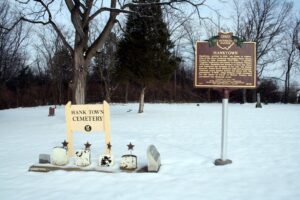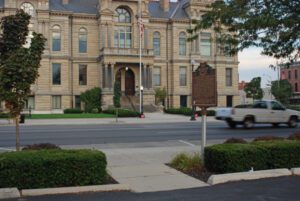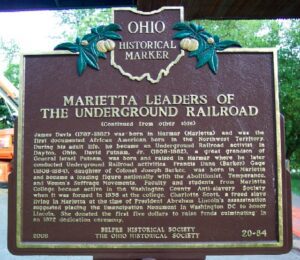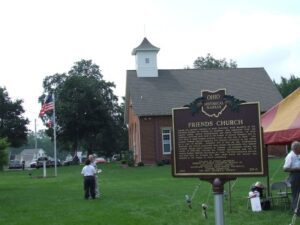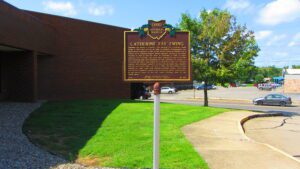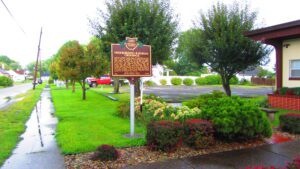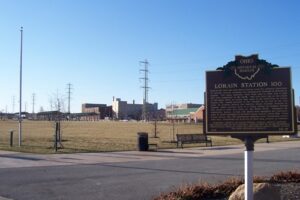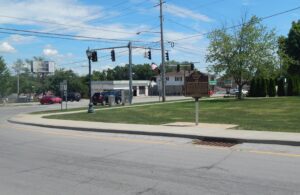, OH
Hanktown, settled in 1846, was home to eighty-nine of the three hundred and eighty-three slaves, owned by John Randolph (1773-1833), a wealthy Virginian landowner and cousin to President Thomas Jefferson. Randolph had decided to free the slaves and indicated the decision in his will. His family, however, found three different wills and protested. Thirteen years passed before the slaves left the plantation. In 1846, Judge William Leigh arranged for the slaves to travel to Mercer County and purchased two thousand acres. (Continued on other side)
, OH
The Fugitive Slave Act of 1850 prompted an expansion of the “Underground Railroad,” and as the state spanning the shortest distance between the Ohio River and Canada, Ohio saw heavy traffic in escaping slaves in the decades before the Civil War. Hancock County was home to many sympathetic residents who defied fugitive slave laws to help conduct slaves to freedom. “Stationmasters” offered safe havens, “conductors” accompanied fugitives through the county, and “stockholders” provided financial support and misled pursuers. Known stations were located mainly along the Perrysburg Road, now U.S. Highway 68. (continued on other side)
, OH
People living in Marietta and along the Muskingum River shared a history of slavery opposition. Manasseh Cutler, from Massachusetts and an Ohio Land Company agent, helped draft the Ordinance of 1787 that prohibited slavery in the Northwest Territory. General Rufus Putnam, Captain Jonathan Stone, and other Ohio Land Company Revolutionary War veterans, founded Marietta at the mouth of the Muskingum River in 1788 bringing with them their anti-slavery sentiments. A proposal to legalize slavery in the proposed state of Ohio was vetoed largely due to the efforts of Marietta’s Ephraim Cutler and General Putnam at the 1802 Ohio Constitutional Convention. These conditions were precursors toward the formation of the Underground Railroad as fugitive slaves crossed the Ohio River seeking freedom. From 1812 through 1861, large numbers of fugitive slaves fleeing toward Canada, were aided by descendants of early settlers who operated Underground Railroad Stations along the Muskingum River. (Continued on other side)
, OH
Among the earliest settlers to Rush Township were members of the Religious Society of Friends or Quakers, who emigrated from the eastern states, mostly Pennsylvania and North Carolina. At first religious services were held in the homes of devout Quakers who in turn built a small-framed meeting house on this site in 1842. The present Friends Church replaced the original structure in the 1870s at a cost of $4,245. Although not a stop on the Underground Railroad, the church supported local ardent Abolitionists who helped runaway slaves reach freedom in Canada. An epidemic during the winter of 1850-1851 reduced the Friends’ membership and led to several Quaker families relocating to Iowa. The final religious service was held here on October 26, 1997, after which the church was donated to the village of North Lewisburg.
, OH
Frances Dana (Barker) Gage was born on October 12, 1808, in Marietta. She married James L. Gage in 1829 and they raised eight children, including four sons who served with Union forces during the Civil War. Throughout much of her life, Frances was deeply involved with the Temperance and Anti-Slavery movements and Women’s Rights issues. Presiding over the Women’s Rights Convention in Akron in 1851, she invited Sojourner Truth to give her famous “Ain’t I a Woman” speech. The Gage family moved in 1853 to St. Louis, the western extension of the Mason-Dixon Line, where her life was threatened whenever she spoke out against slavery. During the Civil War, she traveled south to aid Union soldiers and teach freed slaves. Though crippled and permanently disabled by a stroke, she continued to lecture on social issues until 1867. Frances Dana Gage died on November 10, 1884, in Greenwich, Connecticut.
, OH
Underground Railroad crossings, agents, and conductors were common along the Ohio River between Washington County, Ohio and Wood County, Virginia. At Constitution, six miles upriver from Belpre, Judge Ephraim Cutler listened for hoot owl calls that signaled when a boatload of runaway slaves was crossing from Virginia to the Ohio shore. “Aunt Jenny,” a slave woman in Virginia, used a horn signal to alert abolitionist John Stone in Belpre when fugitive slaves were crossing. At Little Hocking, eight miles downriver from Belpre, slaves crossing from Virginia looked for a lantern signal to guide them to the Horace Curtis Station on the Ohio River shore. Runaway slaves were also assisted by Thomas Vickers at Twin Bridges, James Lawton at Barlow, and others as they traveled northward by various routes through Morgan County to Putnam in Muskingum County where the Underground Railroad merged with the Muskingum River Corridor.
, OH
Prior to the Civil War, Ohio was a leading state for enslaved Americans of African decent traveling the Underground Railroad to freedom in Canada. For these fugitives, their final stop in Ohio was a Lake Erie port community in the north. One such port was at the mouth of the Black River in Lorain that came to be identified as Lorain Station 100, named because it was thought to be one of the last stops or stations before the fugitive slaves reached freedom in Canada. Many arrived here in a wagon driven by Robbins Burrell who owned a farm five miles up the Black River. Concealed by vegetables, grains, or hay, the slaves were smuggled into schooners, some of which belonged to Burrell’s cousin Captain Aaron Root. From Lorain Station 100, the determined travelers were transported across Lake Erie, completing the final leg of their long journey to freedom.
, OH
Activity of the Underground Railroad is believed to have begun in Brookfield Township around 1838 with the first known runaway slaves, two women, to pass through in 1843. Freedom seekers moved north using a system of routes known by operators, or “conductors”. Trumbull County reputedly had over 150 miles of Underground Railroad routes, which would have made it the largest network in Ohio. The slaves that passed through Brookfield Township came mostly from the Youngstown, Poland, and the Canfield areas. From Brookfield they were sent north to Hartford, Kinsman, Burghill, and Vienna ultimately headed to Canada.


